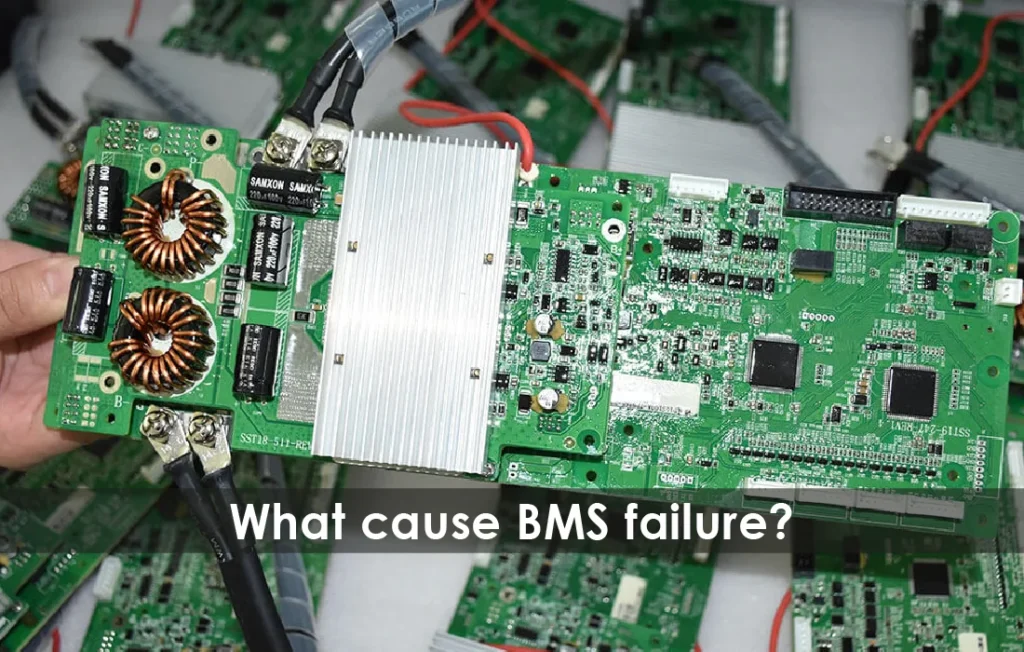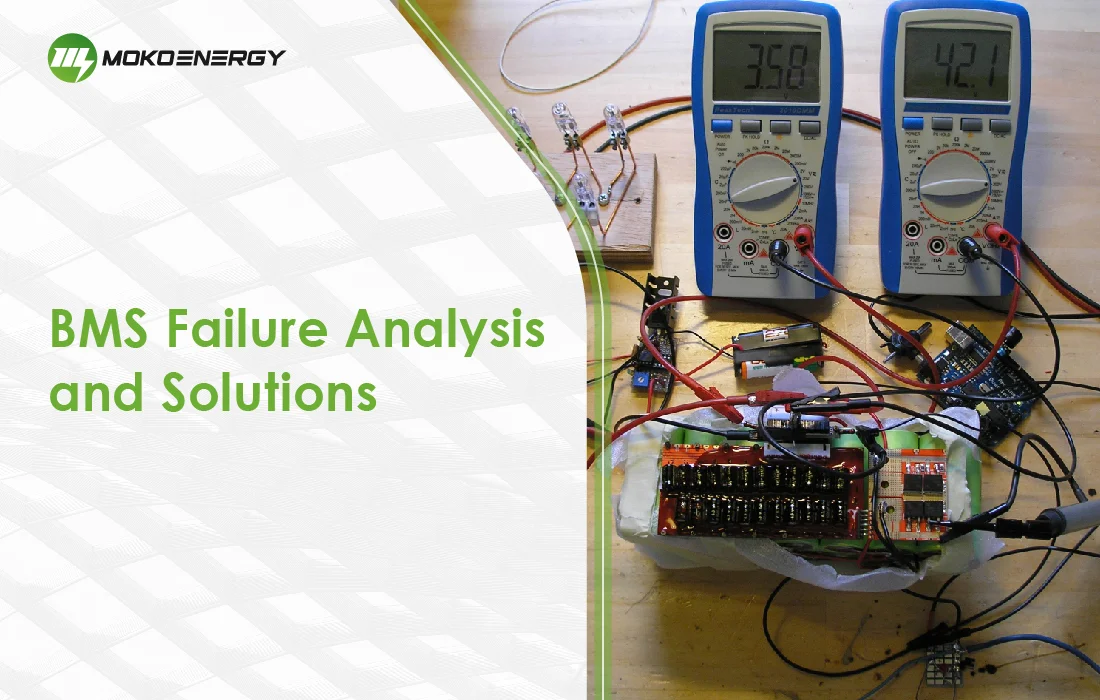BMS is an important accessory of battery pack, it has a lot of functions. It ensures the control of the charging and discharging processes to avoid overcharging or deep discharging, which can greatly improve the cycle life of a battery in everyday applications. Nevertheless, there will be several BMS failures while using. The failure of BMS for batteries may occur for several reasons, and these main failures can be classified into the following categories.
Common BMS Failures And Solutions
A BMS failure can manifest in various ways, each with its own unique set of symptoms and potential causes. Following are the main failures, causes and solutions.

1. The main relay does not engage after power is on
Possible causes: Load detection line is not connected; precharge relay open circuit; precharge resistance open circuit.
Solution: Use the BDU display module to check the bus voltage data, check whether the battery bus voltage and the load bus voltage is normal; check whether the load bus voltage rises during pre-charging.
2. BMS can not communicate with ECU.
Possible causes: BMU (main control module) is not working; CAN signal line is broken.
Solution: Check whether the power supply 12V/24V of BMU is normal; check whether the CAN signaling cable is out of pin or plugged; monitor the data of CAN port, check whether it can receive BMS or ECU data packet.
3. Communication between BMS and ECU is unstable.
Possible causes: Poor matching of external CAN bus; bus branch is too long.
Solution: Check whether the bus matching resistance is correct; whether the matching position is correct and whether the branch is too long.
4. BMS internal communication instability
Possible causes: Loose communication line plug; irregular CAN alignment; duplicate BSU address.
Solution: Check whether the wiring is loose; test whether the bus matching resistance is correct, whether the matching position is correct, whether the branch is too long; check whether the BSU address is repeated.
5. System does not work after power is supplied
Possible causes: Abnormal power supply; short circuit or disconnection of wiring harness; no voltage output from DC/DC.
Solution: Check whether the external power supply to the management system is normal, whether it can reach the minimum working voltage required by the management system, and see whether the external power supply is current-limited settings, which resulting in insufficient power supply to the management system then adjust the external power supply to meet the power requirements of the management system;
Check whether the wiring harness of the management system has a short circuit or a broken circuit, and modify the wiring harness to make it work normally;
If the external power supply and wiring harness are normal, then check whether the DC/DC power supply to the whole system in the management system has voltage output; if there is any abnormality, replace the bad DC/DC module.
6. Battery current data error
Possible causes: The plug of Hall signal cable is loose; the Hall sensor is damaged, the connection is reversed, or the collection module is damaged.
Solution: Re-plug the current Hall sensor signal line; check whether the Hall sensor power supply is normal, whether the signal output is normal; replace the acquisition module.
7. Excessive temperature differentials
Possible causes: Loose cooling fan plug; cooling fan failure; coolant failure; cold zone system does not start.
Solution: Re-plug the fan plug wire; supply power to the fan separately to check whether the fan is normal; replace the coolant; check the cooling system.
8. System error after relay operation
Possible causes: Relay auxiliary contact disconnection, relay contact adhesion
Solution: Re-plug the wiring harness; use a multimeter to measure whether the auxiliary contact on and off state is correct, check the fusing error reporting reasons for exclusion and then replace the relay.
9. Fail to use the charger to charge
Possible causes: Charger and BMS communication is not normal
Solution: Replace a charger or BMS to confirm whether it is BMS failure or charger failure; check whether the matching resistance of BMS charging port is normal.
10. No BMS data display on the vehicle meter
Possible causes: Abnormal wiring harness connection of main control module
Solution: Check whether the wiring harness of the main control module is fully connected, whether there is a normal low voltage of the car, and whether the module is working normally.
11. Loss of test data for some battery boxes
Possible causes: Part of the vehicle connectors may be poor contact, or BMS slave control module does not work properly
Solution: Check the contact condition of the connectors, or replace the BMS module.
12. SOC abnormal
Problem: SOC changes greatly during the system work, or jumps repeatedly between several values; in the system charging and discharging process, SOC has a large deviation; SOC keeps showing a fixed value.
Possible causes:
The current is not calibrated; the current sensor model does not match the host program; the battery has not been deeply charged or discharged for a long time; the data acquisition module collects jumps, causing the SOC to carry out automatic calibration; the Hall sensor is faulty;
Solution: Calibrate the current in the touch screen configuration page; change the host program or replace the current sensor;
Carry out a deep charging and discharging of the battery; replace the data acquisition module, manually calibrate the system SOC, and do deep charging and discharging once a week; modify the program of the host computer, and adjust the xxV in the condition of “the average voltage reaches xxV or above”; set the correct total capacity and the remaining capacity of the battery; Correctly connect the current sensor to make it work properly.
Preventing BMS Failure
As has been described above, there are numerous and diverse causes of BMS failures and yet there are preventive measures that can be taken to reduce the likelihood of failures and to increase the useful life of the BMS.
Initially, this means you need to carry out routine servicing, identify the maintenance schedule and keep logs of any issues noticed or signs of any fault. Ensure that you are attending to any potential issues as soon as you can so as to not let them become major failures.
Selecting high-quality BMS components from reliable manufacturers like MokoEnergy can also contribute to system reliability. Opt for equipment that is suitable for your process and environment and also ensure that you get it fitted and adjusted by experts.
Adding redundancy or fail-safe mechanisms to the design can help prevent or limit problems with single points of failure. Some of the suggestions that can be considered are – the back-up systems, or even the back-up power sources, which are useful to continue with the most critical functions in case of the BMS failure.
Last but not least, keep track of the software versions and firmware releases that are available in the market from the manufacturer. These updates can fix well-documented problems, optimize the functionality of a system, and possibly make the system more stable.
It is always wise to learn about the possible failure situations that may arise in BMS, analyze the possible causes and apply the preventive measures that will help you avoid the frequent cases of costly downtimes and resultant shortening of the battery management system’s lifespan.






